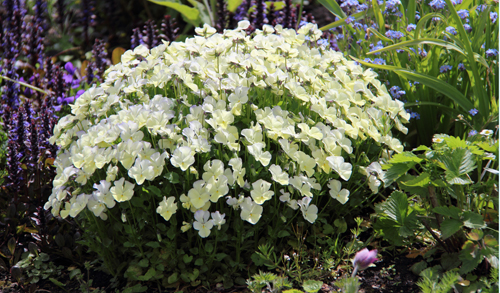20 June 2013
The garden is looking spectacularly colourful at the moment, and is buzzing with bees and other insects. This is the central herbaceous bed today:
This style of garden may or may not be to your taste, but you have to admit it is full of colour and not a mass of messy weeds, which is what a lot of people fear they will have to have if they garden for wildlife. These are the main flowers you can see and some reasons I grow them in a wildlife garden:
- Red rose campion – wild flower. Largely grows itself, but is a superb burst of colour and should be good for moths. It does flop as it finishes its first flowering, so either cut it back or pull it out at this point.
- Cornflower – blue. A hardy annual which you can start in the autumn – as these were – or grow in the Spring: they grow very fast and very easily from seed. Some butterflies will nectar on them.
- The haze of bluish-purple is catmint. Superb for bees, as well as cats. Keep it tidy by cutting back after the first flowering, and you’ll get a second lot.
- The yellow thing sticking up is asphodeline. I’ve been waiting two years for this to bloom, and I don’t think I like it! Oh well, you win some and you lose some.
- The white haze is a garden variety of the wild flower called meadowsweet. Seems to attract the smaller flying insects.
- The blobs of mauve are knautia macedonica – they come in various pastel shades plus deep red. A scabious-type flower, which butterflies will use, then the birds will nibble at the seedheads: as these are on long, slender stems, the birds (usually goldfinches) sway around a lot.
- Foxglove. I let these self seed then move them to where I want them – except for the ones I miss. One of the best flowers for some of the bees, and it’s fascinating to watch the bees disappear up inside the tubes.
- The blue/purple of which you can see a little is a hardy geranium, which is covered in flower. Good for smaller flying insects.
- The large pink blob is an Oriental poppy. I’ve tried to dig up this particular clump three times now, but it keeps coming back. I do like them, but I these were some I was given that were grown from seed and I ended up with three different colours growing together and clashing like mad. Bees and many other insects will use them, getting covered in pollen in the process, to the point where the insects even appear to have changed colour.
- Bright pink hardy geranium ‘Claridge Druce’. A thug, though a pretty one; the white butterflies nectar on it, and bees use it.
- Yellow viola ‘Glenholme’. One of my perennial violas. Not a fantastic insect plant, but no trouble and flowers for months.
- The pale pink mound is astrantia. I’ve only just got these going – they are certainly good for bees, so I await the arrival of more butterflies with interest to see what they think of it.
- Pale mauve viola ‘Maiden’s Blush’ – another perennial, with daintier flowers.
- The tall yellow spikes are sisyrinchium. Not sure how it got here, but I like it. Will watch it to see how the wildlife use it.
- The white flowers you can just glimpse are hardy geranium ‘Kashmir White’. Not sure of its wildlife use.
- Tall bright pinky/red flowers – these are a type of thrift (armeria). Thrift is generally good for bees, but I haven’t noticed anything on this yet – it’s a very different colour to the pale pink of the wild flower.
- The blue blobs are echium ‘Blue bedder’. This is a garden variety of the viper’s bugloss, which is wonderful for bees; I’ve only just planted these out (they are easy to grow from seed) so I’ve yet to see how they perform.
So there you are – 17 flowers, many good for wildlife. I’ve only talked about their potential as nectar plants above, but some will also work as foodplants for butterfly and moth caterpillars – but that’s another post.




